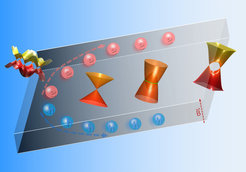Topological semimetals for potential energy conversion application
The dynamic field of topological materials is undergoing vigorous development. In parallel, the field of thermoelectrics passing through a “renaissance” period due to their direct application in “waste heat” recovery and solid-state cooling. As the first-generation 3D topological insulators were discovered in the classic thermoelectric systems Bi1-xSbx and Bi2(Te,Se)3, interesting questions arise as whether there is a connection between topological electronic structure and thermoelectric performance, and whether the newly developed topological materials, such as Dirac and Weyl semimetals, can be potential thermoelectric materials, etc.
In a recent study, scientists from the Max Planck Institute for Chemical Physics of Solids in Dresden have tried to answer the above questions by performing a comprehensive study of thermoelectric and thermomagnetic properties of polycrystalline Weyl semimetal NbP. The advantages of polycrystalline samples, such as being easy to synthesize, exhibiting a lower thermal conductivity, and having an easily tunable Fermi level, facilitate rapid screening of functional materials. For the first time, they have successfully fabricated polycrystalline bulk NbP samples. In the following study, they found that the Nernst thermopower of NbP shows superior value than its conventional Seebeck thermopower. A maximum Nernst power factor of ~ 35×10-4 Wm-1K-2 is achieved at 9 T and 136 K, which is 4 times higher than its conventional power factor (based on Seebeck effect) and is comparable to that of state-of-the-art thermoelectric materials. Moreover, the average Nernst power factor is 6 times higher than the average conventional power factor below room temperature. These results establish polycrystalline Weyl semimetal NbP as a model system for thermomagnetic application and highlight the potential of topological semimetals for power generation and solid-state refrigeration based on the Nernst-Ettingshausen effect and transverse transport. Beyond NbP, many new topological materials have recently been discovered or predicted, among which, those with the combination of topological electronic structure and intrinsically low thermal conductivity could be promising candidates for future energy conversion application.
Ch. F / CPfS

Schematic diagram of a Nernst effect device. The discovered topological semimetals provide a fruitful material platform for exploring novel materials as energy conversion application.












